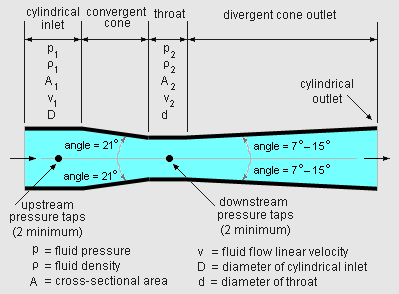User:Milton Beychok/Sandbox: Difference between revisions
imported>Milton Beychok No edit summary |
imported>Milton Beychok No edit summary |
||
| Line 1: | Line 1: | ||
{{Image|Venturi Tube.png|right| | {{Image|Venturi Tube.png|right|400px|Drawing of a classical Venturi tube per ASME Standard MFC-3M-1989.<ref>ASME Standard MFC-3M-1989, ''Measurement of Fluid Flow in Pipes Using Orifice, Nozzle, and Venturi''', American Society of Mechanical Engineers, New York, 1989.</ref>}} | ||
A '''Venturi tube''' (or simply a venturi) is a section of [[Piping (engineering)|piping]] consisting of an inlet converging conical section leading to a small diameter cylindrical section called the ''throat'', followed by a diverging conical section leading to a cylindrical exit (see the adjacent drawing). | A '''Venturi tube''' (or simply a venturi) is a section of [[Piping (engineering)|piping]] consisting of an inlet converging conical section leading to a small diameter cylindrical section called the ''throat'', followed by a diverging conical section leading to a cylindrical exit (see the adjacent drawing). | ||
The volumetric flow rate, '''''Q''''' (m<sup>3</sup>/s), of a fluid flowing through the venturi at any given point is the product of the cross-sectional area, '''''A''''' (m<sup>2</sup>) at that point multiplied by the fluid's linear velocity, '''''v''''' (m/s), at that point. Since the volumetric flow rate is the same at any point within the venturi, the linear velocity of the fluid traveling through the smaller diameter throat of the venturi must increase which results in a decrease of pressure due to the [[conservation of energy]]. | The [[Volume (science)|volumetric]] flow rate, '''''Q''''' (e.g., m<sup>3</sup>/s), of a fluid flowing through the venturi at any given point is the product of the cross-sectional area, '''''A''''' (e.g., m<sup>2</sup>) at that point multiplied by the fluid's linear [[velocity]], '''''v''''' (e.g., m/s), at that point. Since the volumetric flow rate is the same at any point within the venturi, the linear velocity of the fluid traveling through the smaller diameter throat of the venturi must increase which results in a decrease of [[pressure]] due to the [[conservation of energy]]. | ||
The gain in [[kinetic energy]] resulting from the increased linear velocity in the throat is offset (i.e., balanced) by the decrease of pressure in the throat. The reduction in pressure which occurs when the fluid flows through the throat is called the '''''Venturi effect''''' and is named after the Italian physicist [[Giovanni Battista Venturi]] (1746 - 1822) who first observed the effect. | The gain in [[kinetic energy]] resulting from the increased linear velocity in the throat is offset (i.e., balanced) by the decrease of pressure in the throat. The reduction in pressure which occurs when the fluid flows through the throat is called the '''''Venturi effect''''' and is named after the Italian physicist [[Giovanni Battista Venturi]] (1746 - 1822) who first observed the effect. | ||
Thus, referring to the adjacent drawing, the pressure '''''p<sub>2</sub>''''' and the cross-sectional area '''''A<sub>2</sub>''''' in the throat are smaller than the pressure '''''p<sub>1</sub>''''' and the cross-sectional area '''''A<sub>1</sub>''''' in the cylindrical inlet section. The linear velocity '''''v<sub>2</sub>''''' in the throat is higher than the linear velocity '''''v<sub>1</sub>''''' in the inlet section. | Thus, referring to the adjacent drawing, the pressure '''''p<sub>2</sub>''''' and the cross-sectional area '''''A<sub>2</sub>''''' in the throat are smaller than the pressure '''''p<sub>1</sub>''''' and the cross-sectional area '''''A<sub>1</sub>''''' in the cylindrical inlet section. The linear velocity '''''v<sub>2</sub>''''' in the throat is higher than the linear velocity '''''v<sub>1</sub>''''' in the inlet section. | ||
==References== | |||
{{reflist}} | |||
Revision as of 03:23, 18 March 2010
A Venturi tube (or simply a venturi) is a section of piping consisting of an inlet converging conical section leading to a small diameter cylindrical section called the throat, followed by a diverging conical section leading to a cylindrical exit (see the adjacent drawing).
The volumetric flow rate, Q (e.g., m3/s), of a fluid flowing through the venturi at any given point is the product of the cross-sectional area, A (e.g., m2) at that point multiplied by the fluid's linear velocity, v (e.g., m/s), at that point. Since the volumetric flow rate is the same at any point within the venturi, the linear velocity of the fluid traveling through the smaller diameter throat of the venturi must increase which results in a decrease of pressure due to the conservation of energy.
The gain in kinetic energy resulting from the increased linear velocity in the throat is offset (i.e., balanced) by the decrease of pressure in the throat. The reduction in pressure which occurs when the fluid flows through the throat is called the Venturi effect and is named after the Italian physicist Giovanni Battista Venturi (1746 - 1822) who first observed the effect.
Thus, referring to the adjacent drawing, the pressure p2 and the cross-sectional area A2 in the throat are smaller than the pressure p1 and the cross-sectional area A1 in the cylindrical inlet section. The linear velocity v2 in the throat is higher than the linear velocity v1 in the inlet section.
References
- ↑ ASME Standard MFC-3M-1989, Measurement of Fluid Flow in Pipes Using Orifice, Nozzle, and Venturi', American Society of Mechanical Engineers, New York, 1989.
